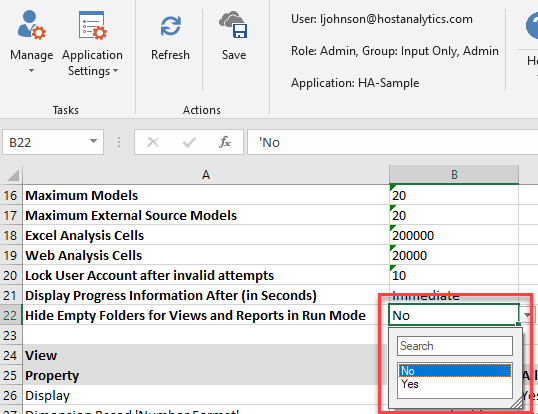- 16 Minutes to read
- Print
- DarkLight
- PDF
Application Settings
- 16 Minutes to read
- Print
- DarkLight
- PDF
Overview
Applications Settings are defined based on Planful Structured Planning, Consolidation, or Reporting applications you are accessing. These settings provide the integration between Dynamic Planning and Planful Structured Planning, Consolidation, or Reporting applications . They also provide Guard Rails, which are limitations to optimize your interaction and user-experience with Dynamic Planning.
Connecting to the Structured Planning, Consolidation, and Reporting Applications
Power user access is required for these steps.
Manage > Application Administration > Application Settings
Fill in the Username and Password under Horizon Uri: this is a login to the exposed Structured Planning, Consolidation, or Reporting application service with the purpose of allowing Metadata download.
Fill in the Username and Password under Soap Uri: this is a login to an exposed Structured Planning, Consolidation, or Reporting application service with the purpose of allowing Data download.
Horizon Uri, Soap Uri, and Tenant Code are protected fields. You must call Support in order to change these fields.
If performing only a Metadata download, Horizon Uri, Username, Password, and Tenant Code must be specified. If performing only a Data download, Soap Uri, Username, Password, and Tenant Code must be specified. Note that the Tenant Code is not necessarily the same as the
Tenant Name for the Structured Planning, Consolidation, and Reporting applications.
Specify the following items if your model will exceed the defaults:
Master model keys: default 1,000,000. Maximum: 1 trillion. Best practice: 100 million. The number of Dimension intersections tagged as Key in Model > Setup for a Master model. Multiply the number of members in each Key dimension by each other to calculate this value. Note that if you have dimensions that will be formed only with one or more Fixed Member mappings, you need to assume that there will be one member parent added to the top of those dimensions.
Master model value block size: default 20,000. Maximum: 100,000. Best practice: 100,000 for a large model. The number of Dimension intersections tagged as Value in Model > Setup for a Master model. Multiply the number of members in each Value dimension by each other to calculate this value. Note that if you have dimensions that will be formed only with one or more Fixed Member mappings, you need to assume that there will be one member parent added to the top of those dimensions. A small model will have a block size of 20,000 or less, medium 50,000-60,000, and large 90,000-100,000.
Maximum models: default 20. Minimum: 1 Maximum: 20. The maximum number of Analytic, Master, and Dynamic models that you want to allow within an application.
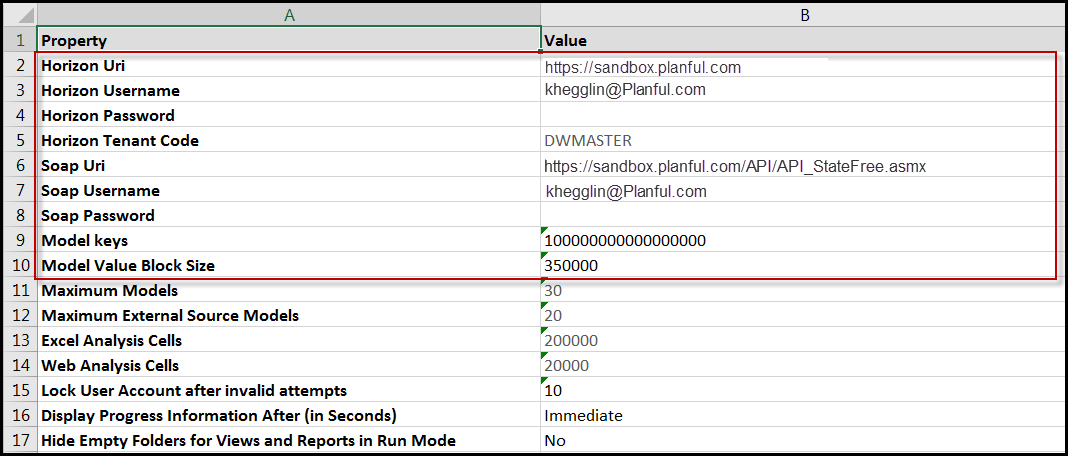
Save. No name is specified, you are saving generic settings for connecting to Structured Planning, Consolidation, and Reporting application. If you later need to connect to a different application (Structured Planning, Consolidation, or Reporting) you need to change the settings here.
When you click Save, the passwords disappear but are still stored internally.
At this point, no models have been created yet in Dynamic Planning.
Description of Fields
The table below describes each of the fields on this page.
| Property/Value | Description | Impact | Value |
|---|---|---|---|
Horizon Uri | This uniform resource identifier (URI) connects Dynamic Planning and Planful Structured Planning, Consolidation, or Reporting applications. This is a read-only setting. To modify this setting, you must submit a Planful Support case. |
|
|
Horizon Username | The name of the Dynamic Planning Power User establishing the connection. |
|
|
Horizon Password | The Power User's password. |
|
|
Horizon Tenant Code | The Planful Structured Planning, Consolidation, and Reporting application name (for example, DWMaster). This is a read-only setting. To modify this setting, you must submit a Planful Support case. |
|
|
Soap Uri | Simple Object Access Protocol (SOAP). This is obtained from the Web Services configuration task in the Planful Structured Planning, Consolidation, and Reporting application. It is called the Session Free State Authentication URL. This is a read-only setting. To modify this setting, you must submit a Planful Support case. |
|
|
Soap Username | The name of the Power User establishing the connection. This is defined in the Web Services configuration task. |
|
|
Soap Password | The Power User's password. This is defined in the Web Services configuration task. |
|
|
Model keys | The maximum number of combinations of Key dimension members in each model in the application. You can see the number of Key dimension members in Model, Setup for all models. Multiply the number of members in each Key dimension by each other to determine this value. For example, if there are 3 dimensions tagged as Key and they have member counts of 100, 200, and 30 then this value would be 600,000, which would be valid. | If this Guard Rail is exceeded, the model will not be created. You need to either change the Key designation or reduce the number of members in the Key dimensions. | Default 1,000,000. Maximum: 1 trillion. Best practice: 100 million. |
Model Value Block Size | The maximum number of combinations of Value dimension members in each model in the application. You can see the number of Value dimension members in Model, Setup. Multiply the number of members in each Value dimension by each other to determine this value. For example, if there are 2 dimensions tagged as Value with member counts of 800 and 20 then this value would be 16,000, which would be valid. Note that Value dimensions are typically those that are always populated with data (such as Time, Scenario, Account) and that do not change frequently. | If this Guard Rail is exceeded, the Model will not be created. You need to either change the Value designation or reduce the number of members in the Value dimensions. | Default 20,000. Maximum: 1,000,000. Best practice: 100,000 for a large model. |
Maximum Models | Total number of models in a single application – both Master and Analytic. This is a read-only setting. To modify this setting, you must submit a Planful Support case. | If this Guard Rail is exceeded, new models are not created. | Maximum of 20. |
Maximum External Source Models | Total number of external source models in a single application. This is a read-only setting. To modify this setting, you must submit a Planful Support case. | If this Guard Rail is exceeded, new models are not created. | Maximum of 20. |
Excel Analysis Cells | Total number of cells on an Analyze grid or Report in SpotlightXL. For example, this would equate to 5000 rows by 40 columns on an Analyze grid. | If Guard Rail is exceeded, a notification is sent indicating the limit has been exceeded. You will need to refine the analysis grid. | 200,000 |
Web Analysis Cells | Total number of cells on an Analyze grid in Spotlight. For example, 20,000 would equate to 1000 rows by 20 columns on an Analyze grid. Note: This setting does not apply to Web Reporting. The best practice and default for the Web Reporting module is 100,000 and it is hidden. If you find that you need more than 100,000 web analysis cells while using Reports on the Web, you must call Planful Support. | If this Guard Rail is exceeded then user will receive a notification indicating that limit has been exceeded and they will need to refine their analysis grid. | Default is 20,000. The best practice recommendation is 20,000. |
Lock User Account after invalid attempts | Specify the number of invalid login attempts. Any attempts beyond that number (by any user) to log in to SpotlightXL or Spotlight will fail. For example, if you select 3 and a user makes 3 invalid login attempts, the user will be locked from accessing Spotlight and SpotlightXL until that user is unlocked by a Power user. Note: If you are the only Power user and you are locked out of Spotlight and SpotlightXL, please contact Planful Support. | Not applicable. | The default value is 10. Power users can change this value based on security needs. |
Display Progress Information After (in Seconds) | Sets whether or not users will see the progress information box while the following operations are executing:
If you click Cancel while viewing a progress information box, SpotlightXL asks you to confirm that you want to cancel. Depending on the type of operation in progress and how far along the operation was, SpotlightXL may stop immediately or complete the operation in the current worksheet but stop before proceeding to the next worksheet. | Select the number of seconds after which a Progress information box will display for operations that take longer than the specified number of seconds to complete. | The default is None. You can enter any number between 1 and 60. For example, if you select 1, the progress bar will appears after 1 second. If you select Immediate, the Progress box will appear immediately after certain user operations. |
Hide Empty Folders for Views and Reports in Run Mode | Sets whether or not users will see empty folders in the folder structure when viewing a list of views and reports to run. | Hides empty folders or shows all folders. | Yes or No |
Global Settings for View and Report Properties
Power users can set default values for key properties available in Views and Reports, which provides flexibility for Power users to define the default behavior from a centralized application page for key properties available in Views and Reports. Power users can also either allow or restrict Contributor and Reviewer users from updating the key properties.
Select the Manage task and the Application Administration, Application Settings subtask.
Defining Default Behavior for View and Report Properties
Under the View and Reports sections, there is a field called Default Value where you can set default property values for Views and Reports.
For Views, a Power user can set the default values, such as Display Label or Code, Indent Row Members, Show Hidden Members, and Enable Save properties. Power users can also select the Data Locking property and Analyze - Tab Color.
For Reports, a Power user can set the default values, such as Display Label or Code, Hide Gridlines, and Hide Headers properties. Default Value for Save on Model and Calculation on Save properties are not applicable. Power users can also select the Data Locking property and Report - Tab Color.
In the example below, under View, Code is selected for Display Label. That means that for all new Views created from the date and time the setting was saved, all Views will display member Codes instead of Display Labels by default. And, under Reports, the Power user selected No for gridlines and headers, which means that any reports created from the date and time the setting was saved will not show gridlines and headers by default. Individual views and reports can vary from these defaults.
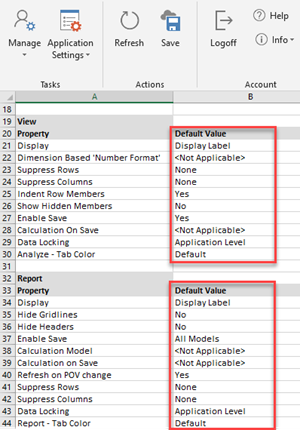
Restricting Contributor and Reviewer Users From Updating View and Report Properties
Navigate to Manage > Application Administration > Application Settings. “Allow Contributors to Update Properties” and “Allow Reviewers to Update Properties” fields are located under the View and Reports sections.
Select properties for Views and Reports that you want to allow or disallow Contributor and Reviewer users to update. For example, you might not allow Contributor and Reviewer users to update the Display Code for Views. For Reports, Contributor users might be able to update the Display Code as well as hide or unhide gridlines and headers.
Defining Default Tab Color for Views and Reports
Under the View and Reports sections, Analyze-Tab Color and Report-Tab Color properties allow you to set the default property values for tab colors in Views and Reports.
- For Views, a Power user can set the default tab color.
- For Reports, a Power user can set the default tab color.
For example, in the View and Analyze sections, consider Blue is selected for Analyze-Tab Color and Red is selected for Report-Tab Color respectively. This means that whenever a user creates new sheets under Views/Reports, tabs will appear in Blue for Views and Red color for Reports.
Users can override the default color defined by the Power user by changing the tab color in a specific View/Report sheet. Color defined by the Power user in Application Settings will be applied only if the View/Report tabs have no color.
This feature provides a visual differentiation between View sheets and Report sheets and will be very helpful for users when they use multi-tab analysis and reporting.
Application Settings - To set the default tab color for Views and Reports.
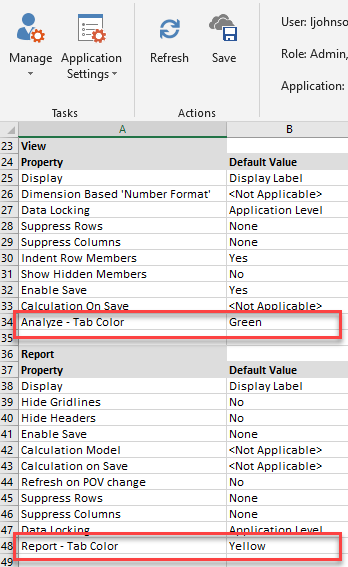
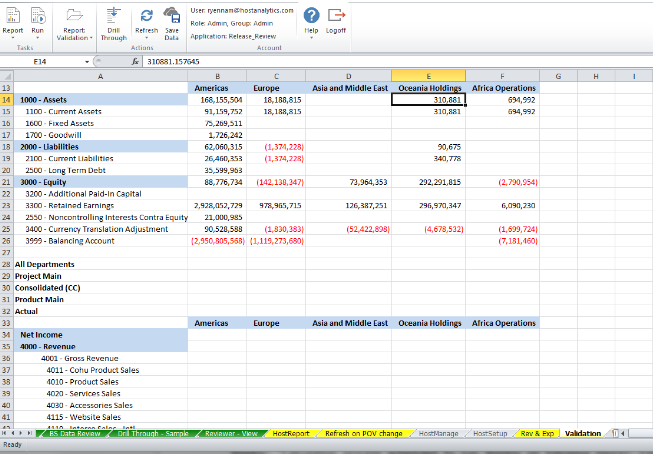
Providing Access to Calculations
In Practice: Providing Calculation Access to Contributor Users
- Navigate to Manage > Application Administration > Application Settings.
- Scroll down to the Calculations heading as shown below.
- Set the Enable User Group Permissions property to Yes.
Power users can assign Groups to the Calculation. Only Contributor users belonging to the assigned Groups will be able to access, modify, and run the Calculation.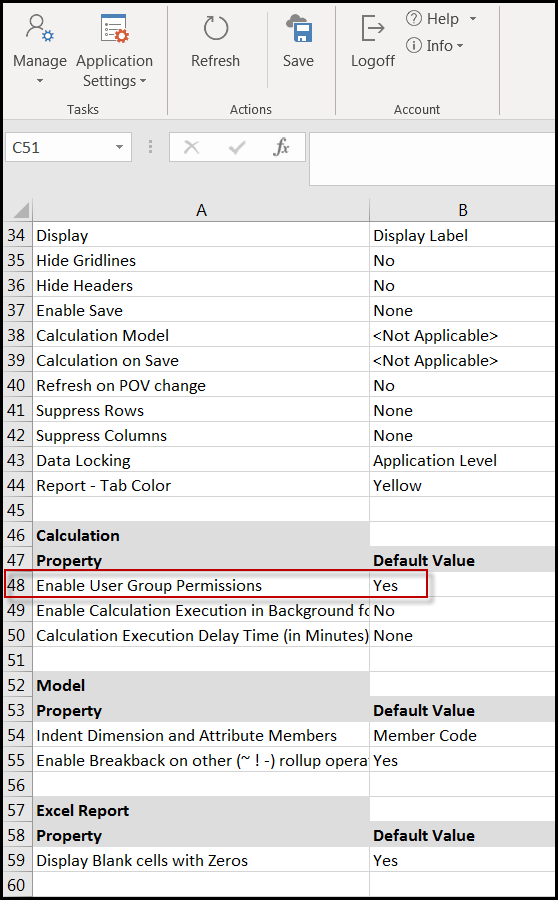
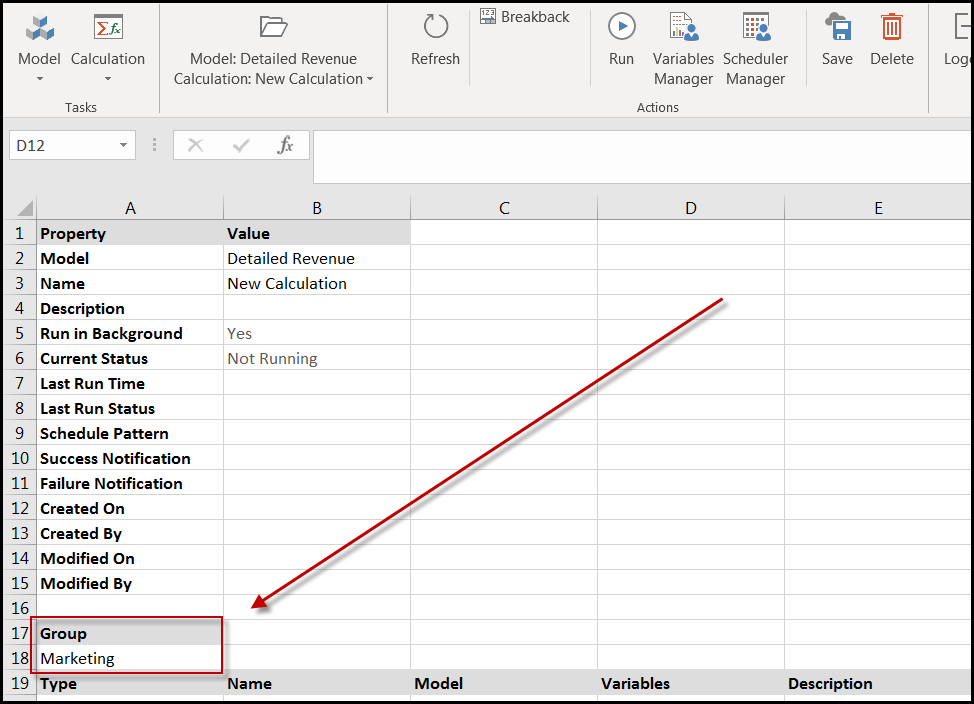
Running Calculations in the Background for Views and Reports
Views and Reports can run a calculation when the user clicks Save. By default, when a calculation is run from a view or report, it runs in the foreground, which prevents users from continuing to work. However, Power users can set an application-wide setting to run calculations in the background for all views and reports that trigger calculations. Those calculations must have been created with the Run in Background field set to Yes. After the calculation has completed its processing, an email is automatically sent to the user that triggered it.
Our recommendation is to set this option to Yes.
In Practice
- Select Manage > Application Administration > Application Settings. Scroll down to the Calculation Property section. After making changes, click Save. Then log off and login again to see the effect of the changes.
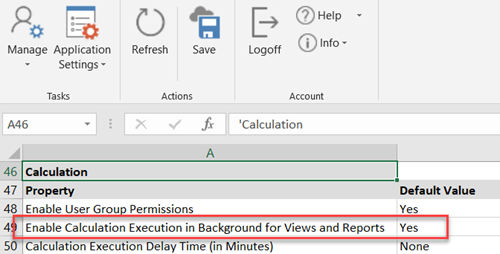
- Select Model, Calculation to ensure that the calculation was set up with Run in Background set to Yes.

- You can see a list of all calculations and their current background setting by choosing Model, Setup. Select the model, then scroll down to the Calculations section.

- Verify that the calculation is set up to run when the user clicks Save from a view or report by reviewing the view or report properties.
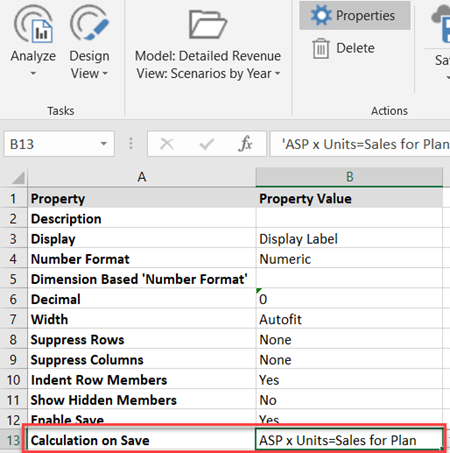
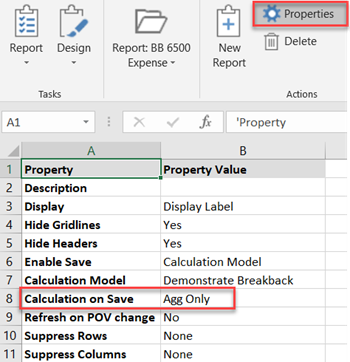
- When the user clicks Save in the view or report, they see the following message:
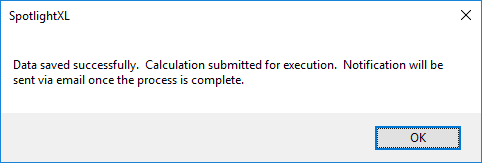 Your title goes hereThe view or report does not refresh the data automatically after the user clicks Save.
Your title goes hereThe view or report does not refresh the data automatically after the user clicks Save.
Calculations Execution Delayed and Batched for Better Performance
Views and Reports can run a calculation when the user clicks Save. Power users can set an application-wide setting to run calculations that are triggered from commonly used views or reports once every few minutes during heavy usage. This setting is dependent on Enable Calculation Execution in Background for Views and Reports being set to Yes.
This setting optimizes calculations by running them at a set interval rather than every time a user triggers them. This is useful for common reports or views that are accessed and used by multiple people who are saving data and triggering calculations to be run frequently. If users are not saving data, the calculation is not run.
For example, during budgeting season, 10 department heads are inputting their plans using the same report.
- Every time they click Save, a calculation is run. This is inefficient because the calculation is being triggered to run frequently.
- When Smart Batching Interval for Calculations is set, the calculation is not automatically run when the user clicks Save. It is delayed.
- Instead, the calculation runs at its next interval.
This setting is effective with the following conditions:
- The users are using the same application and model.
- The users are running and saving data using the same report or view.
- The users are using the same parameters or variables for the calculation in the report.
When you specify a delay time, choose from None, 1, 5, 10, 15, 30, or 60 minutes.
(9).png)
The audit log shows that users are saving and triggering calculations to be run, but the calculation does not run until it is scheduled to do so. In the example below, it is set to run every 5 minutes.


After the calculation runs, each user that triggered it receives an email confirmation that the calculation is completed.
The Power user can see the details of the calculation and the users that have triggered the calculation by selecting Manage, Application Administration, Process Management.
Application-Level Data Locking for Views
This application setting lets Power users enforce locked dimension members for all views at the application level. Power and Contributor users can specify which dimension members are Locked using Model, Model Administration, and Data Locking. Locked members do not allow their data to be modified by user input or calculation.
See Also: How to Lock Dimension Members
To lock dimension members across all views at the application level, select the Manage task and the Application Administration, Application Settings subtask. Under the View Property called Data Locking, select Application Level.
Selecting Application Level applies data locking to all Views for all Models for all users in the Dynamic Planning application.
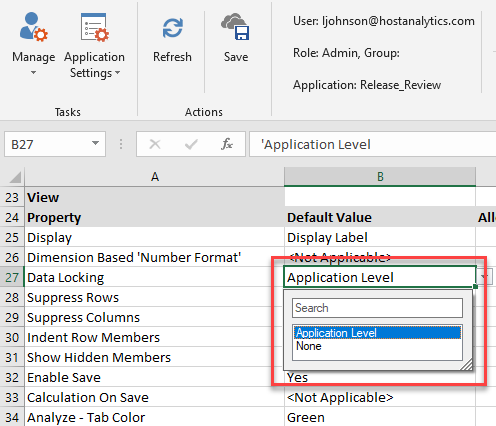
For the Data Locking property, select from the following options:
- Application Level – This is the default. This option turns on data locking in Views. This option is globally applicable for all the Views and all Models in the Dynamic Planning application and for all users.
- None – This option turns off data locking in Views. Although dimension members may be set up as locked, None specifies that these members are not locked in Views.
Application-Level Data Locking for Reports
This application setting lets Power users enforce locked dimension members for all reports at the application level. Power and Contributor users can specify which dimension members are Locked using Model, Model Administration, Data Locking. Locked members do not allow their data to be modified by user input in reports.
See Also: How to Lock Dimension Members
To lock dimension members across all views at the application level, select the Manage task and the Application Administration, Application Settings subtask. Under the Report Property called Data Locking, select Application Level (shown below).
Selecting Application Level applies data locking to all Reports for all Models for all users in the Dynamic Planning application.
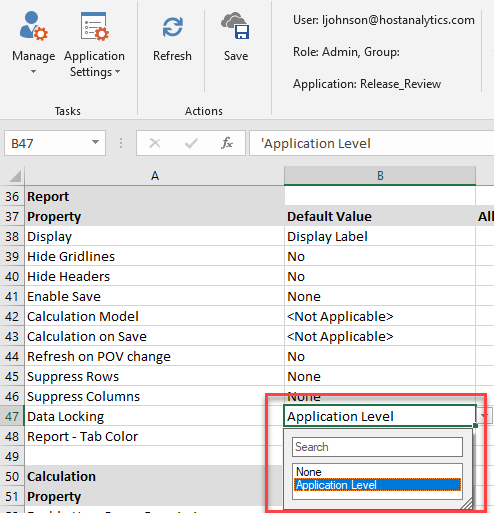
For the Data Locking property, select from the following options:
- Application Level – This is the default. This option turns on data locking in Reports. This option is globally applicable for all the Reports and all Models in the Dynamic Planning application and for all users.
- None – This option turns off data locking in Reports. Although dimension members may be set up as locked, None specifies that these members are not locked in Reports. If you want to specify individual cell-level locking within a report, you can use Report Design and Format Manager as shown below.
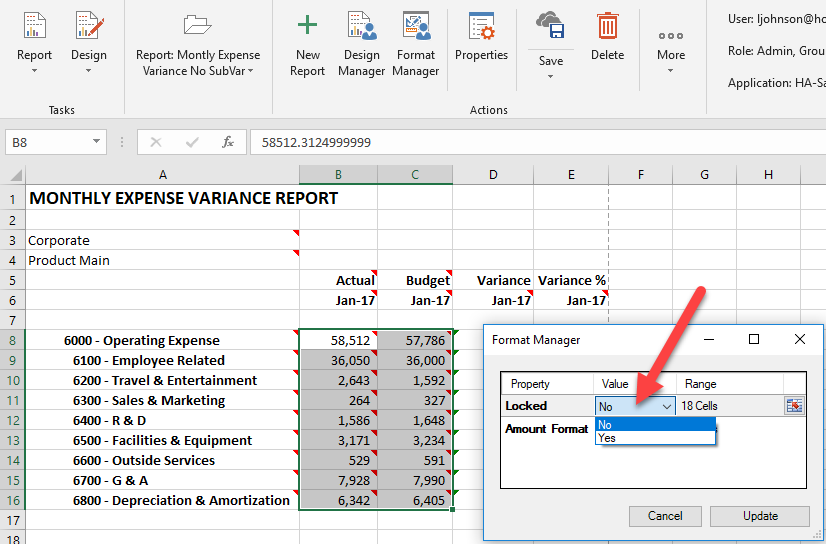
Indenting Dimension Members
You can display dimension members on the Model Dimension page with indentations based on the level as shown below.
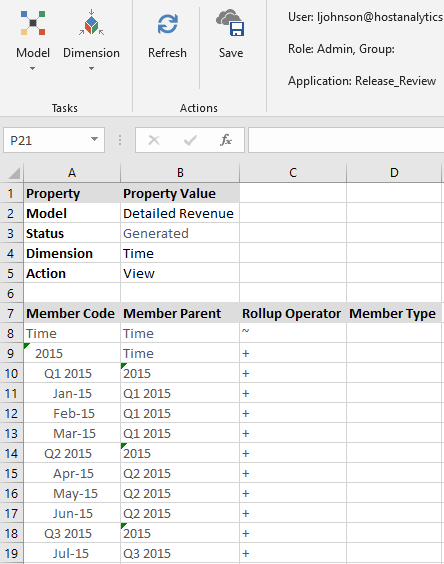
Power users can change the settings from the Application Settings page shown below.
- None (no indentation)
- Member Code (indents only member code column)
- Member Code & Parent (indents both member code and member parent columns)
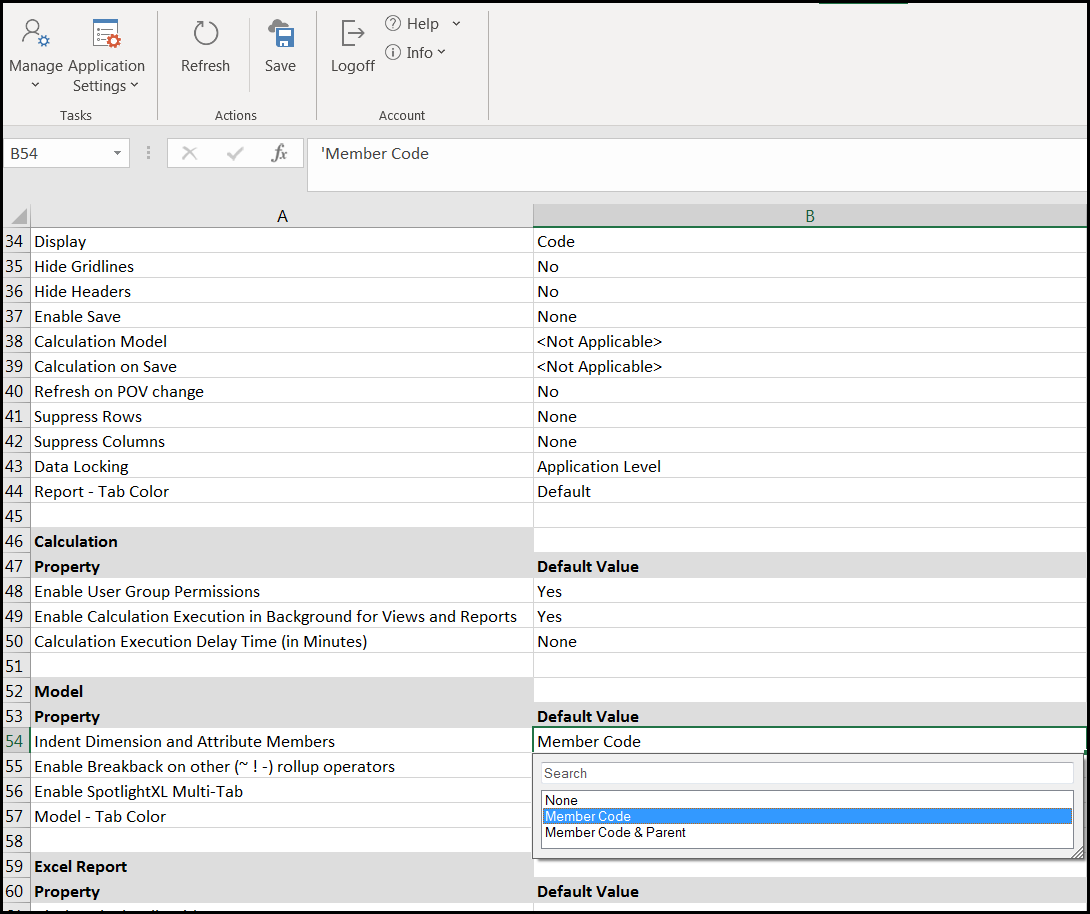
Hiding Empty Folders for Views and Reports
This is an Application Setting that lets you choose whether or not you see empty folders in the list of views and reports. Only Power users can change this setting, and it takes effect for all models in the application, for all users.
For example, if you have a long list of reports and some are organized into folders, you can hide excess empty folders.
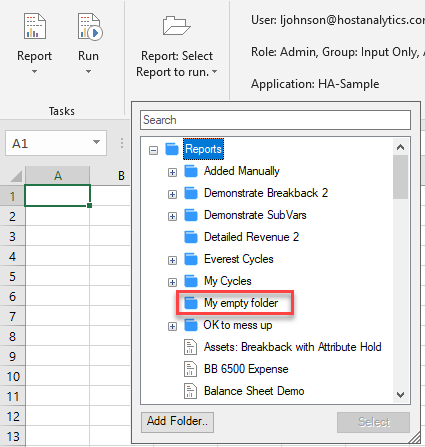
To change the setting, Power users must do the following steps:
- Select Manage > Application Administration > Application Settings.
- Next to Hide Empty Folders for Views and Reports in Run Mode, select Yes or No.
- When set to Yes, folders with no views or reports in them will be hidden from view in the folder structure.
- When set to No, all folders will be visible at all times. This is the default.
- Save your changes.
You must logoff and login again to see the effects of the changed setting.